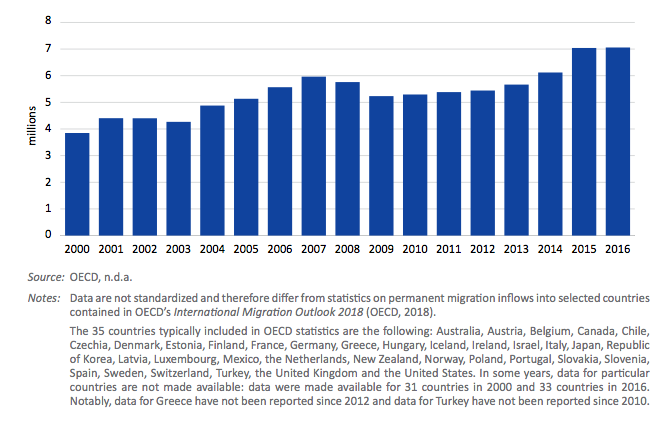While data on migrant stocks are widely available, data on global migration movements (flows) are much more limited. Available UN DESA estimates on global migrant stocks are extensive and global in scope; however, the database of migration flows only encompasses 45 countries. Capturing data on migration flows is extremely challenging for several reasons. First, while international migration flows are generally accepted as covering inflows and outflows into and from countries, there has been a greater focus on recording inflows. For example, while countries such as Australia and the United States count cross-border movements, many others only count entries and not departures. Additionally, migration flow data in some countries are derived from administrative events related to immigration status (for example, issuance/renewal/withdrawal of a residence permit) and are thus used as a proxy for migration flows. Furthermore, migratory movements are often hard to separate from non-migratory travel, such as tourism or business. Tracking migratory movements also requires considerable resources, infrastructure and IT / knowledge systems. This poses particular challenges for developing countries, where the ability to collect, administer, analyse and report data on mobility, migration and other areas is often limited. Finally, many countries’ physical geographies pose tremendous challenges for collecting data on migration flows. Entry and border management, for example, is particularly challenging in some regions, because of archipelagic and isolated borders, and it is further complicated by traditions of informal migration for work.
There are currently two main international datasets on international migration flows, both of which are derived from national statistics: UN DESA’s International Migration Flows dataset and OECD’s International Migration Database. Since 2005, UN DESA has compiled data on the flows of international migrants to and from selected countries, based on nationally available statistics. So far, there had been no update to the UN DESA flows dataset, with the most current being the 2015 version. The 2015 migration flows dataset comprises data from 45 countries (only 43 on emigration flows), up from 29 countries in 2008 and 15 countries in 2005.
The OECD data on migration flows have been collected since 2000, which allows for limited trend analysis, as shown in figure below (though data are not standardised, as explained in the note under the figure). The estimates suggest that permanent migration inflows to OECD countries increased from 3.85 million in 2000 to 7.06 million in 2016, with a temporary lull occurring around the time of the global financial crisis. Germany remained the main OECD destination country in 2016, with over 1.7 million new international migrants (more than double the levels registered in 2000, but with a decrease compared with more than 2 million in 2015) arriving that year, followed by the United States (nearly 1.2 million) and the United Kingdom (about 450,000 new migrants).
Inflows of foreign nationals into OECD countries, permanent migration, 2000–2016 (millions)

SOURCES: UN DESA, OECD, IOM
IMAGE CREDIT: Wikimedia Commons
_medium.jpeg)
